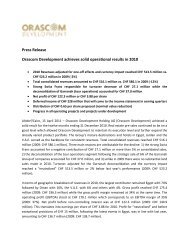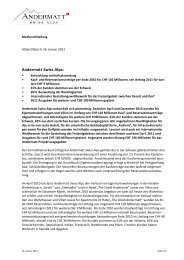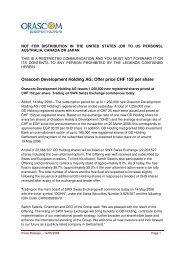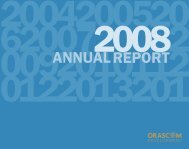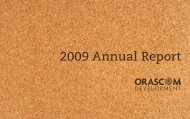FY 2012 Annual Report - Orascom Development
FY 2012 Annual Report - Orascom Development
FY 2012 Annual Report - Orascom Development
You also want an ePaper? Increase the reach of your titles
YUMPU automatically turns print PDFs into web optimized ePapers that Google loves.
F-71 <strong>Orascom</strong> <strong>Development</strong> <strong>2012</strong> <strong>Annual</strong> <strong>Report</strong> F-72<br />
The sensitivity analysis includes outstanding borrowings, impact of the changes in the fair value of derivative instruments<br />
designated as cash flow hedges and receivables in foreign currencies and, where appropriate, loans to foreign operations within<br />
the Group where the denomination of the loan is in a currency other than the functional currency of the lender or the borrower.<br />
A positive number below indicates an increase in profit or equity where the CHF strengths 5% against the relevant currency. For a<br />
5% weakening of the CHF against the relevant currency, there would be a comparable impact on the profit or equity, and the<br />
balances below would be negative.<br />
CHF Currency USD Impact Currency EUR Impact Currency EGP Impact<br />
<strong>2012</strong> 2011 <strong>2012</strong> 2011 <strong>2012</strong> 2011<br />
Profit or loss 7,760,113 6,937,068 2,752,375 3,075,846 6,301,744 4,253,738<br />
Equity 55,887 52,135 - - - -<br />
The Group's sensitivity to foreign currency has changed in accordance with the changes in EGP, USD and AED borrowings.<br />
Forward foreign exchange contracts<br />
It is the policy of the Group to enter into forward foreign exchange contracts to cover specific foreign currency receipts within 25%<br />
to 30% of the exposure generated. At 31 December <strong>2012</strong>, the Group has no outstanding forward foreign currency exchange<br />
contracts. However, the Group entered during the current year into several forward foreign currency exchange contracts to hedge<br />
part of the Group’s receivables denominated in EUR and USD.<br />
At 31 December <strong>2012</strong>, no ineffectiveness has been recognised in profit or loss arising from the Group’s hedging activities.<br />
40.7 Interest rate risk management<br />
The Group is exposed to interest rate risk because entities in the Group borrow funds at both fixed and floating interest rates. The<br />
risk is managed by the Group by maintaining an appropriate mix between fixed and floating rate borrowings, and by the use of<br />
interest rate swap contracts. Hedging activities are evaluated regularly to align with interest rate views and defined risk appetite,<br />
ensuring the most cost-effective hedging strategies are applied. The Group's exposures to interest rates on financial assets and<br />
financial liabilities are detailed in the liquidity risk management section of this note.<br />
At 31 December <strong>2012</strong>, the Group held one interest rate swap contract (IRS) under which the Group agrees to exchange the<br />
difference between fixed and floating rate interest amounts calculated on the agreed notional principal amount. The notional<br />
amount of the IRS contract is based on the outstanding amount of one of the long-term borrowings. The group was engaged in<br />
this contract on September 2008 and it will expire on June 2014.<br />
As the interest rate swap exchanges floating rate interest amounts for fixed rate interest amounts it is designated as a cash flow<br />
hedge in order to reduce the Group’s cash flow exposure resulting from variable interest rates on borrowings. The interest rate<br />
swap and the interest payments on the borrowing occur simultaneously and the amount accumulated in equity is reclassified in<br />
profit or loss over the period that the floating rate interest payments on debt affect profit or loss.<br />
The Group receives the fair value of the swap from the counterparty bank at the end of each reporting period and is disclosed<br />
below. The average interest rate is based on the outstanding balances at the end of the reporting period.<br />
Management has assessed that the cash flow hedge is 100% effective and therefore the entire change in fair value of the interest<br />
rate swap is recognised in other comprehensive income and accumulated in equity (note 28.3).<br />
The following table details the notional principal amount and remaining terms of the interest rate swap contract outstanding at<br />
the end of the reporting period.<br />
40.7.1 Interest rate sensitivity analysis<br />
The sensitivity analyses below have been determined based on the exposure to interest rates for both derivatives and nonderivative<br />
instruments at the end of the reporting period. For floating rate liabilities, the analysis is prepared assuming the amount<br />
of liability outstanding at the end of reporting period was outstanding for the whole year. A ‘100 basis point’ (1%) increase or<br />
decrease is used when reporting interest rate risk internally to key management personnel and represents management’s<br />
assessment of the reasonably possible change in interest rates.<br />
If interest rates had been 100 basis points higher / lower and all other variables were held constant, the Group’s profit for the year<br />
ended 31 December <strong>2012</strong> would decrease / increase by CHF 2.5 million (2011: decrease / increase by CHF 2.6 million). This is mainly<br />
attributable to the Group’s exposure to interest rates on its variable rate borrowings.<br />
40.8 Other price risks<br />
The Group is exposed to equity price risks arising from equity investments. Equity investments are held for strategic rather than<br />
trading purposes. The Group does not actively trade these investments.<br />
40.9 Credit risk management<br />
Credit risk refers to the risk that a counterparty will default on its contractual obligations resulting in financial loss to the Group.<br />
The Group credit risk arises from transactions with counterparties, mainly individual customers and corporations. The Group has<br />
adopted a policy of only dealing with creditworthy counterparties and obtaining sufficient collateral, where appropriate, as a<br />
means of mitigating the risk of financial loss from defaults.<br />
The Group’s exposure to credit risk is, to a great extent, influenced by the individual characteristics of each customer. Risk control<br />
assesses the credit quality of the customer, taking into account its financial position, past experience, other publicly available<br />
financial information, its own trading records and other factors, where appropriate, as a means of mitigating the risk of financial<br />
loss from defaults. The Group’s exposure is continuously monitored and the aggregate value of transactions concluded is spread<br />
amongst approved counterparties.<br />
Trade receivables consist of a large number of customers, spread across various industries and geographical areas. The Group<br />
does not have any significant credit risk exposure to any single counterparty or any Group of counterparties having similar<br />
characteristics. The Group defines counterparties as having similar characteristics if they are related entities. The credit risk on<br />
sales of real estate is limited because the Group controls this risk through the property itself by registering the unit in the name of<br />
the customer only after receiving the entire amount due from the customer.<br />
Counterparty risk is also minimized by ensuring that 80% of derivative financial instruments, money market investments and<br />
current account deposits are placed with financial institutions whose credit standings are above Aa1 and 20% above BB+.<br />
The carrying amount of financial assets recorded in the financial statements, which is net of impairment losses, represents the<br />
Group’s maximum exposure to credit risk without taking account of the value of any collateral obtained.<br />
40.10 Liquidity risk management<br />
Ultimate responsibility for liquidity risk management rests with the Board of Directors, which has established an appropriate<br />
liquidity risk management framework for the management of the Group’s short-, medium- and long-term funding and liquidity<br />
management requirements. The Group manages liquidity risk by maintaining adequate reserves, banking facilities and reserve<br />
borrowing facilities, by continuously monitoring forecast and actual cash flows and matching the maturity profiles of financial<br />
assets and liabilities. Regarding management’s plans to manage liquidity shortages and related uncertainty please refer to note<br />
43.1.<br />
As of 31 December <strong>2012</strong>, total un-drawn facilities, that the Group has at its disposal in order to further reduce liquidity risk, are<br />
CHF 23.7 million (31 December 2011: CHF 6 million).<br />
Last instalment date Average contracted Notional principal amount Fair value assets (liabilities)<br />
Fixed interest rate CHF CHF<br />
<strong>2012</strong> 2011 <strong>2012</strong> 2011 <strong>2012</strong> 2011<br />
30-Jun-14 3.50% 3.50% 34,856,237 35,827,969 (562,337) (1,264,931)<br />
The interest rate swap settles on a half-yearly basis. The floating rate on the interest rate swaps is based on LIBOR for 6 months.<br />
The Group settles the difference between the fixed and floating interest rate on a net basis.<br />
F-71<br />
F-72



